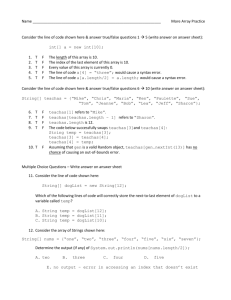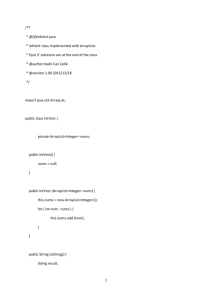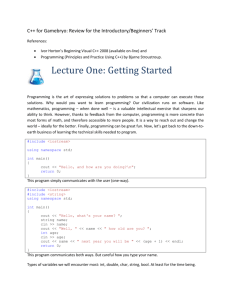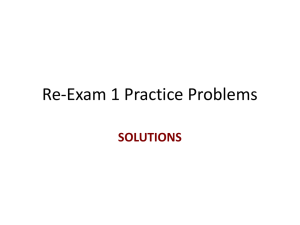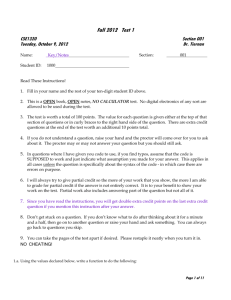CS112 Computation for the Sciences
advertisement
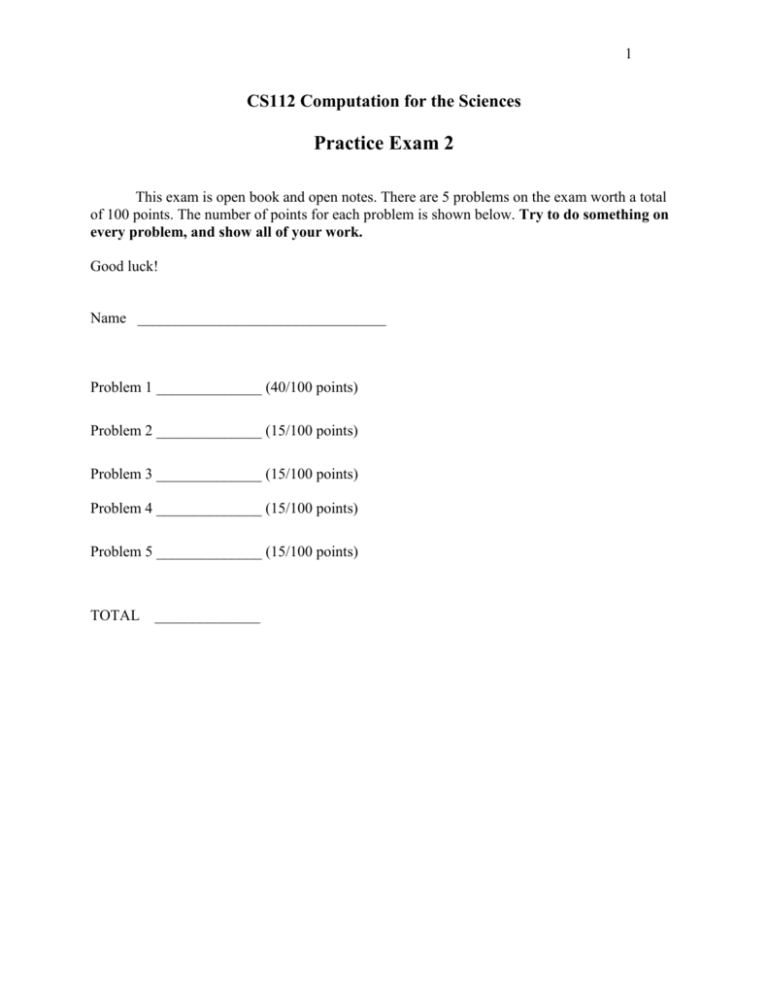
1 CS112 Computation for the Sciences Practice Exam 2 This exam is open book and open notes. There are 5 problems on the exam worth a total of 100 points. The number of points for each problem is shown below. Try to do something on every problem, and show all of your work. Good luck! Name _________________________________ Problem 1 ______________ (40/100 points) Problem 2 ______________ (15/100 points) Problem 3 ______________ (15/100 points) Problem 4 ______________ (15/100 points) Problem 5 ______________ (15/100 points) TOTAL ______________ 2 Problem 1: Looping with for and while (40 points) An element of a vector can be removed by assigning the contents of its location to the empty vector, []. In the following example, the nums vector initially has five elements, but after executing the statement nums(3) = [], the third element is removed and the nums vector only contains four elements: >> nums = [7 2 8 1 3] nums = 7 2 8 >> nums(3) = [] nums = 7 2 1 1 3 3 The removeDuplicates function, as defined below, contains bugs. The intent of this function is to remove duplicates of any values that are repeated in the input nums vector, and return the modified vector with the duplicates removed: function removeDuplicates (nums) n = length(nums); for i = 1:n if (any(nums(1:i-1) == nums(i))) nums(i) = []; end end The following is an example of the intended behavior of the removeDuplicates function: >> nums = [2 1 7 8 2 6 7 7 3 8]; >> newNums = removeDuplicates (nums) 2 1 7 8 6 3 Part a (10 points): Describe the errors in the current definition of removeDuplicates and modify the definition to fix these errors. Your revised function should still contain a for loop. 3 Part b (15 points): Rewrite the removeDuplicates function using a while statement instead of a for statement, to loop through the input nums vector. 4 Part c (15 points): Hand simulate the mystery function defined below, and indicate what is printed by the following sequence of statements: >> nums = [8 2 7 3 6]; >> newNumbers = mystery(nums) >> nums >> function newnums = mystery(nums) for i = length(nums):-1:2 [val index] = max(nums(1:i)); temp = nums(i); nums(i) = nums(index); nums(index) = temp; end newnums = nums; What does the mystery function do, in general? 5 Problem 2: Nested for loops (15 points) Write a function sumMX that has a single input that is a 2-D matrix that is assumed to contain all 0’s and 1’s, and a single output that is a 2-D matrix of the same size. This function should count the number of 1’s contained in a 3x3 block centered at each location of the input matrix, and store this sum at the corresponding location of the output matrix. You do not need to calculate these sums for the locations around the border of the image (the first and last row and column) – the output matrix can contain zeros at these locations. Given the following input matrix: 1 0 1 0 1 0 1 0 1 1 1 0 0 0 1 1 1 1 0 0 0 1 0 1 1 The sumMX function should return the following output matrix: 0 0 0 0 0 0 4 3 5 0 0 5 4 4 0 0 5 4 4 0 0 0 0 0 0 6 Problem 3: Function inputs and outputs (15 points) A student has written the following functions (using very poor choices of variables and no comments) in an M-file named myFunction.m. function [a b c] = myFunction(a, b, c) [c b a] = mySubFunction(a,b); function [a b c] = mySubFunction(x, y, z) if (nargin == 2) z = 4; end nums = [x y z]; a = max(nums); c = min(nums); b = nums((nums ~= a) & (nums ~= c)); What are the values returned in the variables a,b, and c when the following command is typed into MATLAB’s Command Window? >> [a b c] = myFunction(2,1,3); 7 Problem 4: Reading files from folders (15 points) Suppose the Current Directory contains a folder named images that stores many image files with a .jpg file extension. Write a function named countLargeImages that reads in each image file in the images folder and counts the number of images that have at least one dimension whose size is greater than 100. The countLargeImages function should have no inputs and should return the total number of large images. 8 Problem 5: Structures (15 points) The following picture portrays the contents of a structure named claire that stores assignment, exam and project grades for a student in a course: Part a (9 points): Define a function addGrade that has three inputs: (1) a structure that contains the fields shown above, (2) the name of a category specified as a string, e.g. ‘assignment’, ‘exam’ or ‘project’, and (3) a new grade. The addGrade function should return the structure with the new grade added to the end of the vector of grades in the specified category. Part b (6 points): Write a script named testGrade that contains code to create the structure portrayed in the above picture and then calls the addGrade function three times, to add a new assignment grade of 94, a new exam grade of 87 and a new project grade of 91. 9 CS112 Computation for the Sciences Practice Exam 2 Solutions Problem 1: Looping with for and while The following buggy code was given: function removeDuplicates (nums) n = length(nums); for i = 1:n if (any(nums(1:i-1) == nums(i))) nums(i) = []; end end Part a: There are two errors in this function. First, the function should return the modified nums vector, but there is no output parameter specified in the header of the function. Second, the control variable for the loop, i, spans the values from 1 to n, where n is the length of the original nums vector. As elements are removed from nums, it becomes shorter, so eventually an out-of-bounds error is encountered, when the index i exceeds the new length of the nums vector. When i is 1, the expression 1:i-1 evaluates to 1:0, which is the empty vector, but this does not actually generate an error. The following definition fixes the errors in this function, preserving the use of a for statement: function newNums = removeDuplicates (nums) n = length(nums); newNums = []; for i = 1:n if ~(any(nums(1:i-1) == nums(i))) newNums = [newNums nums(i)]; % alternative: newNums(end+1) = nums(i); end end Part b: Here is one way to implement the function using a while loop: function newNums = removeDuplicates (nums) n = length(nums); newNums = []; i = 1; while (i <= n) if ~(any(nums(1:i-1) == nums(i))) newNums = [newNums nums(i)]; end i = i + 1; end 10 Part c: The function mystery sorts the numbers contained in the input nums vector in increasing order, using a sorting strategy known as selection sort. Suppose there are n numbers in the input vector. The selection sort algorithm first places the maximum value into the last location (index n) of the vector. Then the second largest value is placed at index n-1, the third largest value is placed at index n-2, and so on. When a number is moved from an index i to its final place at the index given by index, the contents at index are moved down to index i. When mystery is called with the vector [8 2 7 3 6], the contents of the nums vector after each iteration of the for loop are as follows: initial values: i = 5: [6 2 7 3 i = 4: [6 2 3 7 i = 3: [3 2 6 7 i = 2: [2 3 6 7 [8 2 7 3 6] 8] 8] 8] 8] This results in the following printout from the specified commands: >> nums = [8 2 7 3 6]; >> newNumbers = mystery(nums) newNumbers = 2 3 6 7 8 >> nums nums = 8 2 7 3 6 >> Problem 2: Nested for loops The following is one possible definition of sumMX: function outMX = sumMX(inMX) [rows cols] = size(inMX); outMX = zeros(rows, cols) for row = 2:rows-1 for col = 2:cols-1 outMX(row, col) = sum(sum(inMX(row-1:row+1, col-1:col+1))); end end Problem 3: Function inputs and outputs The following printout shows the values returned in the variables a, b, and c when the following command is typed into MATLAB’s Command Window: 11 >> [a b c] = myFunction(2,1,3) a = 1 b = 2 c = 4 Problem 4: Reading files from folders Here is one implementation of the countlargeImages function: function count = countLargeImages folderName = [pwd filesep 'images' filesep]; fileNames = dir([folderName '*.jpg']); count = 0; for i = 1:length(fileNames) im = imread([folderName fileNames(i).name]); if (max(size(im)) >= 100) count = count+1; end end Problem 5: Structures The addGrade function can be defined as follows: function newStructure = addGrade (oldStructure, category, grade) if strcmp(category, 'assignment') oldStructure.assignments(end+1) = grade; elseif strcmp(category, 'exam') oldStructure.exams(end+1) = grade; else oldStructure.projects(end+1) = grade; end newStructure = oldStructure; The following script creates the claire structure and tests the addGrade function: % testGrade.m script claire.assignments = [82 97 90 85 89]; claire.exams = [83 91]; claire.projects = [95 93]; claire = addGrade(claire, 'assignment', 94); claire = addGrade(claire, 'exam', 87); claire = addGrade(claire, 'project', 91);
